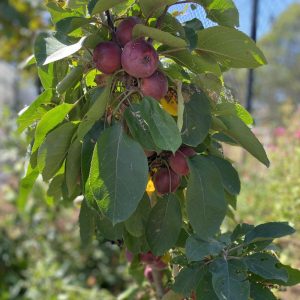Crabapples – an oft overlooked resource!
Robin Gale-Baker, from Sustainable Macleod, discusses growing crabapples. This is one of a series of articles she has written about growing fruit trees (see right hand sidebar). She has also written a number of articles about growing various vegetables, growing various herbs and general growing techniques.
 Crabapples are a resource often overlooked by gardeners. There are many benefits of planting a crabapple or two – beautiful flowers and foliage, great for pollinators and, of course, the apples have many culinary uses. Crabapple, like apple, belongs to the Malus genus and the Rosaceae family and is a small to medium tree, though can become sprawling if unpruned. There are around 20 varieties available in Australia.
Crabapples are a resource often overlooked by gardeners. There are many benefits of planting a crabapple or two – beautiful flowers and foliage, great for pollinators and, of course, the apples have many culinary uses. Crabapple, like apple, belongs to the Malus genus and the Rosaceae family and is a small to medium tree, though can become sprawling if unpruned. There are around 20 varieties available in Australia.
Crabapples come in many colours in foliage, flower and fruit. Foliage ranges through green, red and purple, some turning in autumn to reds and purples. The flowers range from white to white-pink, pale pink, deep pink, red and purple. The fruit can be red, orange, yellow or purple. Crabapples are regarded as a ‘blossom’ tree in spring and a tree of autumnal colour in autumn. The fruit can last from summer to winter, hanging in winter like baubles, after the tree sheds its leaves and providing winter colour.
Trees can be bought potted or bare-rooted in winter. If space is at a premium, buy one grafted onto dwarf root stock.
Crabapples are unfussy about soil but prefer it well drained. Plant in a sunny spot for best results. Dig a hole large enough that all the roots can spread out, add some compost and backfill, water and mulch. In its first few years, water it regularly but once established it will rarely need watering.
Prune for shape and to remove broken, dead and diseased limbs in winter. Crabapples are such good attractants for pollinators that they are often grown in apple orchards to increase pollination. They are self-fertile so one is enough in a home garden (unless you want more).
Crabapples are often regarded as ornamental trees rather than ‘fruiting’ trees. The main difference between an ornamental and edible one is fruit size. Ornamental trees may have no fruit or only very small, inedible fruit while edible ones have fruit that is at least 3 cm in diameter. The crabapple fruit is quite sour so is generally processed with a sweetener to make it palatable. Having said that, some are sweet enough to be eaten from the tree. The fruit is generally ripe for harvest in autumn.
Crabapples have a very high pectin level and can be made into syrup that is added to other fruit for jam and jelly making. Crabapple jelly is perhaps the best known use for the fruit but other uses include cakes, breads, scones and muffins, as an addition to an apple dessert, fruit leathers, sauces, pastes, butters and juices, pickling and cordial making.
Sally Wise, a Tasmanian author in her book A year in a bottle has a recipe for crabapple lemonade that I have made and it is delicious. The ingredients are crabapples, sugar, lemon, cider vinegar and cold water. The mix needs to sit for two weeks in a food safe bucket before being ready to use. At this point it will be fizzy. Her book also includes recipes for crabapple jelly, jam and cheese.

We have recently inherited my husband’s family farm in the Hunter Valley. The federation cottage is near derelict and the once thriving garden is a mess. No one has lived here for years. The fact that anything has survived the 8 year drought and total neglect is a miracle so I was very excited to find a gorgeous crabapple (with purple fruit developing), a re-sprouted fig (also fruiting) and a huge pear tree (just laden). Now to research recipes!
Hi Jan,
I am not certain that you can make crabapple jelly from green crabapples. There are some varieties of green crabapple but if your fruit is usually red, yellow, orange or purple then the green is non-ripe fruit and won’t have developed its sugars to make a good jelly – possibly not its pectin either.
Green crabapple varieties usually have very small fruit. You could try to make a crabapple lemonade. There’s a recipe in Sally Wise’s recipe book ‘A Year in a Bottle’. (She’s from Tasmania). It is very easy and you could add more sugar to compensate for the lack of ripeness.
I am struggling to find information about green fruit from a crabapple tree. The fruit has all fallen from the tree, but it is as green as a Granny Smith apple. I am trying to find out if I can make crabapple jelly from the green fruit or does it have to colour up. The tree has lost its leaves now. I need to do something with the fruit! Jelly is the preferred option. Thank you and for the information above.